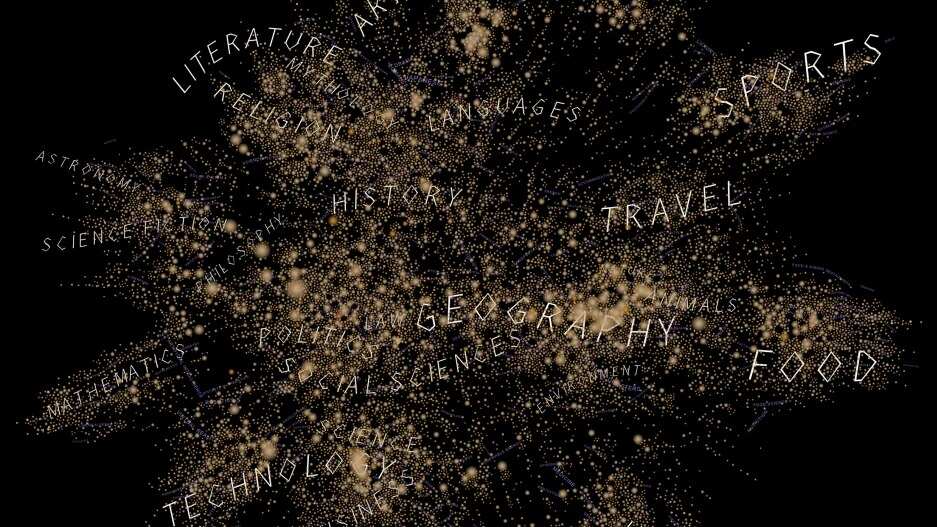- | 8:00 am
If ChatGPT had a brain, this is what it would look like
A new data visualization tool from Kim Albrecht reveals the unexpected way ChatGPT organizes its information.

When ChatGPT launched in November 2022, Kim Albrecht, like millions of others, created an account. Albrecht, whose research focuses on data visualization, wanted a firmer grasp on the kind of information that the artificial intelligence contained—and also what it lacked.
Over the past 10 months, Albrecht has submitted more than 1,700 prompts to ChatGPT’s application programming interface, asking the platform what knowledge it possesses. His research culminated with the launch of Artificial Worldviews, an interactive map that resembles a galaxy and contains more than 32,000 stars symbolizing answers given by the app on various topics.
“I was hoping to create an interface that makes it easy for people to dive in and find these things within the domains that they have knowledge about,” Albrecht said. “Systems will always have a tendency towards something, and to me it’s crucial in this moment to try to understand what this tendency is.”
Albrecht initially asked the interface an extremely nonspecific question: What knowledge does it possess? ChatGPT gave vague outputs listing broad subjects such as food, geography, and medicine. From there, Albrecht asked ChatGPT to tell him what it knew about these subfields.
As Albrecht dove deeper into his research, the findings surprised him. He found that of the top five most frequently mentioned people, three were women involved in environmental and conservation fields. Rachel Carson, the author of Silent Spring, yielded 73 mentions—more than any other human. Jane Goodall, the primatologist, came in second at 60 mentions. Kenyan activist Wangari Maathai, sandwiched in between Aristotle and Isaac Newton, holds the fourth spot with 44 mentions.
These major nodes on Albrecht’s map raise questions about how ChatGPT parses a prompt and sources its answers. “The question becomes: Are Rachel Carson and Jane Goodall individuals whose research spreads especially well? Research that transcends fields and categories? Or is something else happening here?” Albrecht asks on the Artificial Worldviews website. “Might OpenAI set certain parameters that lead to the design of such a list . . . or is GPT on its way to becoming general artificial intelligence and cares a lot for the planet and the environment?”
Though Albrecht believed it was promising to find that ChatGPT’s results seem to skew more female, more diverse, less religious, and seemingly more environmentally conscious than other databases—for example, the Pantheon Project, in which the first female listed is Mary, mother of Jesus, who ranks 33rd—he cautioned that likely not all AI interfaces will yield similar results.
As ChatGPT becomes increasingly popular, researchers are calling attention to some of the flaws and dangers that the platform poses, ranging from misinformation to promotion of dangerous content. Albrecht noted that because ChatGPT has moderation guidelines censoring harmful or difficult topics like war and sex, he didn’t receive many outputs related to those subjects.
“There are lots of things that are part of human nature or that are part of the world that this system is not at all [showing],” he said.
Because ChatGPT is still evolving and honing its censorship of certain topics, Albrecht said that his search results in recent months were much more restrictive than they were last fall. At the same time, the content that the AI platform promotes is probably the most unencumbered version of itself that it will ever be.
“It’s an interesting moment that we have right now because the systems are still not totally occupied by capitalism,” Albrecht said, explaining that he could see ChatGPT eventually soliciting advertisements or sponsorships, similar to how Google promotes certain content through its search results. “The versions we’re getting back from this map are, in that way, maybe a bit more pure than they will be in a couple of years.”
Overall, Albrecht hopes that his map will serve as a tool for ChatGPT users to consider what content the platform presents when asked a question or given a prompt, why, and who might be behind the data that the interface has been trained on.
“Who should define the list of the most important photographers, or the most important people in medicine? It’s nothing anyone can say [with certainty],” he said. “I think at least this map can act as something where you can check your own beliefs against the beliefs of other systems.”





































